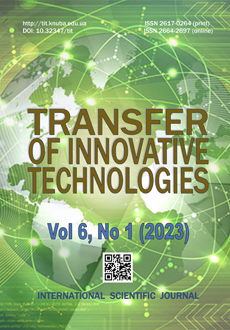Fire and biological protection of paper and corrugated board with an impregnating composition
DOI:
https://doi.org/10.32347/tit.2023.61.0102Keywords:
flame retardant, paper, corrugated board, impregnating composition, flammabilityAbstract
The issue of fire protection of cellulosic materials has been studied in the works of domestic and foreign scientists. However, there are still a number of unresolved problems in this area: modern means are not effective enough, the treated products are unaesthetic, do not meet performance indicators, and do not resist biodegradation. It has been established that volatile mixtures of pyrolysis products differ significantly in the content of combustible gases. Thus, for the treated samples, the amount of methane decreases by 30 times, hydrogen – by 25...30 times, carbon monoxide – by 35...40 times, and the amount of non-combustible gases increases: carbon dioxide - by 1.2...2 times, nitrogen – by 1.4...5 times. Studies on determining the smoke-forming capacity of untreated and treated paper samples showed an 8-fold decrease in the smoke-forming coefficient for treated paper samples and their transition from the group of materials with high smoke-forming capacity (untreated samples) to the group of materials with moderate smoke-forming capacity. Tests were conducted to determine the flammability of corrugated cardboard samples used for packaging various materials, including combustibles: untreated samples are classified as flammable materials, and treated samples are classified as flammable materials with a 42.38 kg/m3 absorption of the impregnating composition in terms of anhydrous substance.
Studies have been conducted on the fire and biological protection of paper and products made of it with an impregnating composition that can effectively protect against fire and biological degradation without compromising the aesthetic and operational characteristics of these materials, taking into account modern environmental requirements. To determine the flame retardant effect of the impregnating composition, thermal destruction of untreated and treated paper samples was performed. In the course of the study, volatile products of thermal degradation were collected and their gas chromatographic analysis was carried out.
References
Tsapko Yu., Tsapko А. (2018). Establishment of fire protective effectiveness of reed treated with an impregnating solution and coatings. Eastern-European Journal Enterprise Technolo-gies, 4, 10 (94), 62-68. https://doi.org/10.15587/ 1729-4061.2018.141030. (in Ukrainian).
Tsapko Yu., Bondarenko O., Tsapko A. (2019). Effect of a flame-retardant coating on the burning parameters of wood samples. Eastern-European Journal Enterprise Technologies, 2. 10 (98), 49-54; DOI: 10.15587/1729-4061.2019.163591. (in Ukrainian).
Tsapko Yu., Tsapko А., Bondarenko O. (2019). Establishment of heat-exchange process regularities at inflammation of reed samples. Eastern-European Journal Enterprise Technologies, 1, 10 (97), 36-42; DOI: 10.15587/1729-4061.2019.156644. (in Ukrainian).
Krüger S., Gluth G.J.G., Watolla M.B., Morys M., Häßler D., Schartel B. (2016). Neue Wege: Reaktive Brandschutz-beschichtungen für Extrembedingungen. Bautechnik, 93, 8, 531-542.
Zhartovskyi V. M., Barylo O. G., Tsapko Y. V., Moroz V. M., Lyashenko S. A. (2004). Fire and bio protection of paper and paper materials. Scientific Bulletin of UkrNDIPB, 2 (10), 86-90. (in Ukrainian).
Zhartovsky V.M., Tsapko Y.V., Lyashenko S.A., Barylo O.G. (2004). Determination of the optimal formulation of the composition for fire and bio protection of paper. Collection of scientific papers. Lviv: LIPB, 5, 128-133 (in Ukrainian).
Tsapko Y. V., Barylo O. G., Lyashenko S. A. (2006). Physicochemical studies on the development of a composition for fire and biological protection of cellulose-containing materials. Natural sciences and their application in the activities of the civil protection service. International scientific and practical conference Cherkasy-2006, 124-126. (in Ukrainian).
DSTU 4155-2003. (2003). Textile materials. Method of flammability test [In force since 2004-01-01], 7 (in Ukrainian).
DSTU B B.1.1-2-97. (1997). Building materials. Method of flammability test [In force since 1998-01-01], 28. (in Ukrainian).
DSTU B B.2.7-68-98. (1998). Building materials. Nonwoven fabrics (backing) for linoleum. Test methods [In force since 1998-07-01], 28. (in Ukrainian).
Downloads
Published
How to Cite
Issue
Section
License
Copyright (c) 2023 Yuriy Tsapko, Olga Bondarenko, Аleksey Tsapko, Diana Zherebchuk

This work is licensed under a Creative Commons Attribution 4.0 International License.
Our journal abides by the CREATIVE COMMONS copyright rights and permissions for open access journals.
Authors, who are published in this journal, agree to the following conditions:
1. The authors reserve the right to authorship of the work and pass the first publication right of this work to the journal under the terms of a Creative Commons Attribution License, which allows others to freely distribute the published research with the obligatory reference to the authors of the original work and the first publication of the work in this journal.
2. The authors have the right to conclude separate supplement agreements that relate to non-exclusive work distribution in the form in which it has been published by the journal (for example, to upload the work to the online storage of the journal or publish it as part of a monograph), provided that the reference to the first publication of the work in this journal is included.




